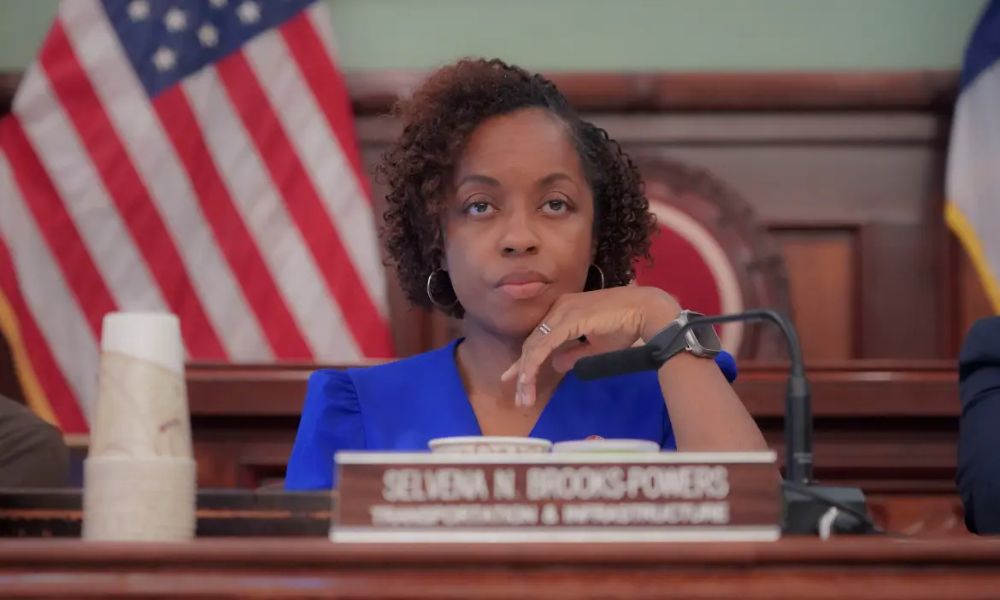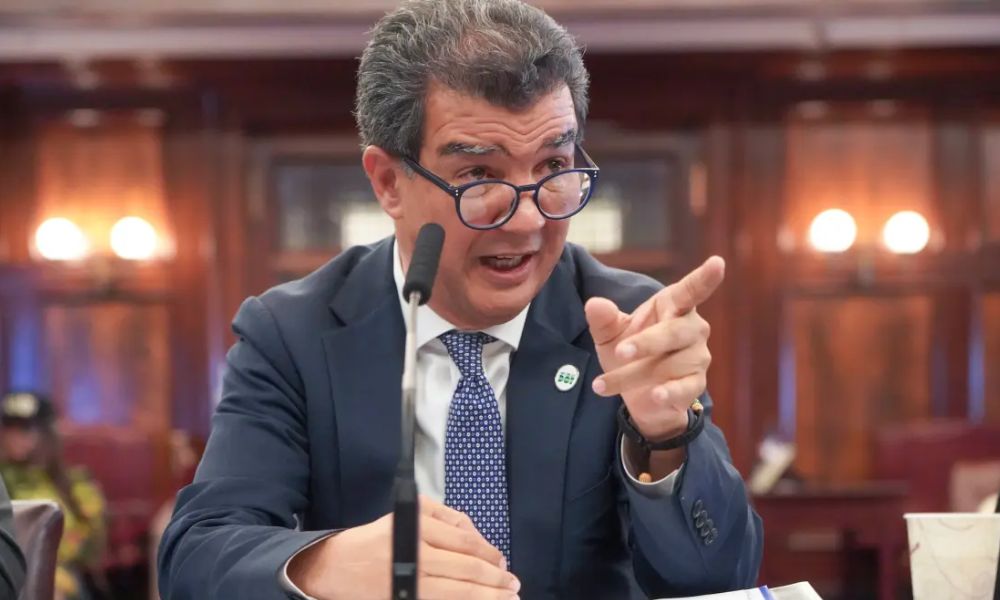
Bike lane or parking lot? Council Member Selvena Brooks-Powers favors the parking lot.
Queens, NY – City Council Transportation Chair Selvena Brooks-Powers has called on Mayor Eric Adams to remove a protected bike lane in her district, arguing that “no one uses it”—a claim that critics say is only true because drivers regularly occupy the lane with illegally parked cars.
Instead of pushing for stricter enforcement to keep the bike lane on Beach 20th Street clear, Brooks-Powers urged the city to revert the roadway to its previous state, despite safety concerns.
“We’ve been trying to get [the bike lane] removed for three years,” Brooks-Powers stated during a “community conversation” in Arverne, Queens, on Wednesday. “It wasn’t supported by the community. … In effect, it’s not a bike lane quite honestly; no one uses it, they [drivers] park there. We would like to see the hard infrastructure removed.”

Selvena Brooks-Powers during a recent Transportation Committee hearing. (Photo: Gerardo Romo / NYC Council Media Unit)
A Contradiction in the Council
Ironically, just hours before making this demand, Brooks-Powers was in a heated exchange with DOT Commissioner Ydanis Rodriguez in the City Council chambers—17 miles from her district—criticizing the Adams administration for failing to construct enough protected bike lanes.
“The report noted that the DOT installed roughly 29 miles of protected bike lanes in 2024, which is an improvement but still less than the 50-mile benchmark required,” she told Rodriguez.
Rodriguez responded by emphasizing the need for cooperation from local officials.
“Fifty miles of bike lanes is not realistic unless everyone is on board, unless every Council member comes and says, ‘I want bike lanes in my district,’” said Rodriguez.
Later that same day, however, Brooks-Powers requested a bike lane removal in her district—directly contradicting her earlier push for more protected lanes citywide.

Commissioner Rodriguez informs the council that community support is essential for the new bike lanes.
Photo: (Gerardo Romo / NYC Council Media Unit)
Cyclists and Advocates React
The demand to remove the Beach 20th Street bike lane has sparked outrage among cyclists and transportation advocates.
“I cannot believe that was even entertained by the head of the Transportation Committee, who earlier in the day was stressing the need for more bike lanes,” said Jim Burke, a leader in Queens’ cycling community.
Installed under the de Blasio administration in 2019, the raised two-way bike lane on Beach 20th Street between Mott and Cornaga avenues was designed as a key connection to the beach. The lane was built with “mountable” curbs to serve as an emergency access route, but in reality, it has been taken over by illegal parking—forcing cyclists into dangerous detours.
“If the issue is that cars are illegally parking on it, then that has to be addressed,” added Burke. “Why should the illegal parkers—the ones breaking the law—get to dictate the safety of everyone else?”
Despite the backlash, DOT Commissioner Rodriguez did not directly defend the Beach 20th Street lane, instead agreeing to a walk-through of the area with Brooks-Powers and local community members. However, DOT spokesperson Will Livingston later reaffirmed the agency’s stance on maintaining safety infrastructure.
“We will be exploring ways to harden this bike lane in the future and working with NYPD to increase enforcement efforts to prevent illegal parking,” Livingston said.
A Pattern of Backtracking on Bike Lanes
Since the launch of the Vision Zero initiative under former Mayor Bill de Blasio in 2014, the DOT has rarely removed protected bike lanes due to community opposition. One notable exception occurred in 2018 when pressure from then-Manhattan Borough President Gale Brewer and Rep. Adriano Espaillat led to the removal of bike lanes on Dykman Streets in Manhattan—a decision later reversed.
Mayor Adams echoed concerns about balancing bike lane expansion with local interests.
“There needs to be a balance,” Adams said at the meeting. “That’s the conversation I have with the commissioner all the time—you’ve got to have a balance.”
However, critics argue that this “balance” has led to a failure to meet legally required goals for both bike and bus lane expansion. Several planned safety improvements—including on McGuinness Boulevard and Ashland Place—have been delayed or watered down due to political pressure.
In stark contrast to the situation in Queens, community members in Brooklyn recently voted to demand the completion of the Ashland Place protected bike lane, which currently ends abruptly, creating hazards for cyclists.
As city officials continue debating the future of bike lanes, advocates fear that prioritizing illegal parkers over cyclist safety could set a dangerous precedent across New York City.
